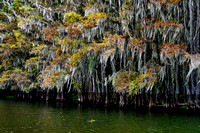Conditions were not good for color this year plus we were at least a week early for peak color.
Caddo Lake encompasses 26,810 acres in Texas and Louisiana and harbors more than 70 species of fish.
Spanish explorers first arrived in Texas in 1542. French explorers arrived in 1685. Both groups encountered the Caddo on the Red River in the late 1600s. The Caddo successfully traded and negotiated with the newcomers.
The Caddo began to settle in the area near Caddo Lake around the 1800. They built ceremonial centers and maintained far-reaching trade routes. They hunted game with bows and arrows, fished, and farmed corn, beans and squash.
But conflict arose between the Spanish and French over Caddo territory. American settlement from the east and attacks from neighboring Native tribes led to increased loss of Caddo territory by the middle 1800s. The United States government forcibly moved the Caddo to Oklahoma in 1859.
In 1691, Spanish explorer Domingo Teran de los Ríos encountered an impassible logjam on the Red River. The American Freemen-Custis Expedition was rerouted by the same “Great Raft” of fallen, partially submerged trees blocking the river in 1806.
The Great Raft consisted of uprooted trees piled in the river for over 80 miles. For centuries, spring flooding eroded riverbanks, toppled trees and increased logjams. The raft disrupted river flow and water spilled into Louisiana’s Cypress Valley, forming a lake around 1800.
That lake was named for the Caddoan people.
Captain Henry Miller Shreve invented the first boat for removing snags, large trees entrenched in riverbeds. From 1832 to 1839, Shreve supervised the removal of the Great Raft with four snag boats and a crew of 150 men. By 1835, riverboats could navigate the Red River, Caddo Lake and Big Cypress Bayou.
However, floods continued, and new logjams formed. In 1871, the Army Corps of Engineers cleared snags with explosives and dredged the river to prevent future logjams.
With the Great Raft partially cleared in 1835, riverboat travel and commerce spurred economic growth in port towns from Jefferson on the Big Cypress Bayou down to New Orleans, LA.
Oil was discovered below Caddo Lake during the 1900s oil boom. The Gulf Refining Corporation dammed the lake to raise the water level to accommodate oil drilling equipment in 1914. The U.S. Army Corps of Engineers completed the current dam in Mooringsport, LA, in 1971. [Since water is always present now there will never be any new trees since they require dry ground for several months to germinate and grow.]
Caddo Lake State Park opened on July 4, 1934. Lady Bird Johnson’s father, T.J. Taylor, was one of several wealthy donors who gave private land for the park.
Caddo Lake encompasses 26,810 acres in Texas and Louisiana and harbors more than 70 species of fish.
Spanish explorers first arrived in Texas in 1542. French explorers arrived in 1685. Both groups encountered the Caddo on the Red River in the late 1600s. The Caddo successfully traded and negotiated with the newcomers.
The Caddo began to settle in the area near Caddo Lake around the 1800. They built ceremonial centers and maintained far-reaching trade routes. They hunted game with bows and arrows, fished, and farmed corn, beans and squash.
But conflict arose between the Spanish and French over Caddo territory. American settlement from the east and attacks from neighboring Native tribes led to increased loss of Caddo territory by the middle 1800s. The United States government forcibly moved the Caddo to Oklahoma in 1859.
In 1691, Spanish explorer Domingo Teran de los Ríos encountered an impassible logjam on the Red River. The American Freemen-Custis Expedition was rerouted by the same “Great Raft” of fallen, partially submerged trees blocking the river in 1806.
The Great Raft consisted of uprooted trees piled in the river for over 80 miles. For centuries, spring flooding eroded riverbanks, toppled trees and increased logjams. The raft disrupted river flow and water spilled into Louisiana’s Cypress Valley, forming a lake around 1800.
That lake was named for the Caddoan people.
Captain Henry Miller Shreve invented the first boat for removing snags, large trees entrenched in riverbeds. From 1832 to 1839, Shreve supervised the removal of the Great Raft with four snag boats and a crew of 150 men. By 1835, riverboats could navigate the Red River, Caddo Lake and Big Cypress Bayou.
However, floods continued, and new logjams formed. In 1871, the Army Corps of Engineers cleared snags with explosives and dredged the river to prevent future logjams.
With the Great Raft partially cleared in 1835, riverboat travel and commerce spurred economic growth in port towns from Jefferson on the Big Cypress Bayou down to New Orleans, LA.
Oil was discovered below Caddo Lake during the 1900s oil boom. The Gulf Refining Corporation dammed the lake to raise the water level to accommodate oil drilling equipment in 1914. The U.S. Army Corps of Engineers completed the current dam in Mooringsport, LA, in 1971. [Since water is always present now there will never be any new trees since they require dry ground for several months to germinate and grow.]
Caddo Lake State Park opened on July 4, 1934. Lady Bird Johnson’s father, T.J. Taylor, was one of several wealthy donors who gave private land for the park.












